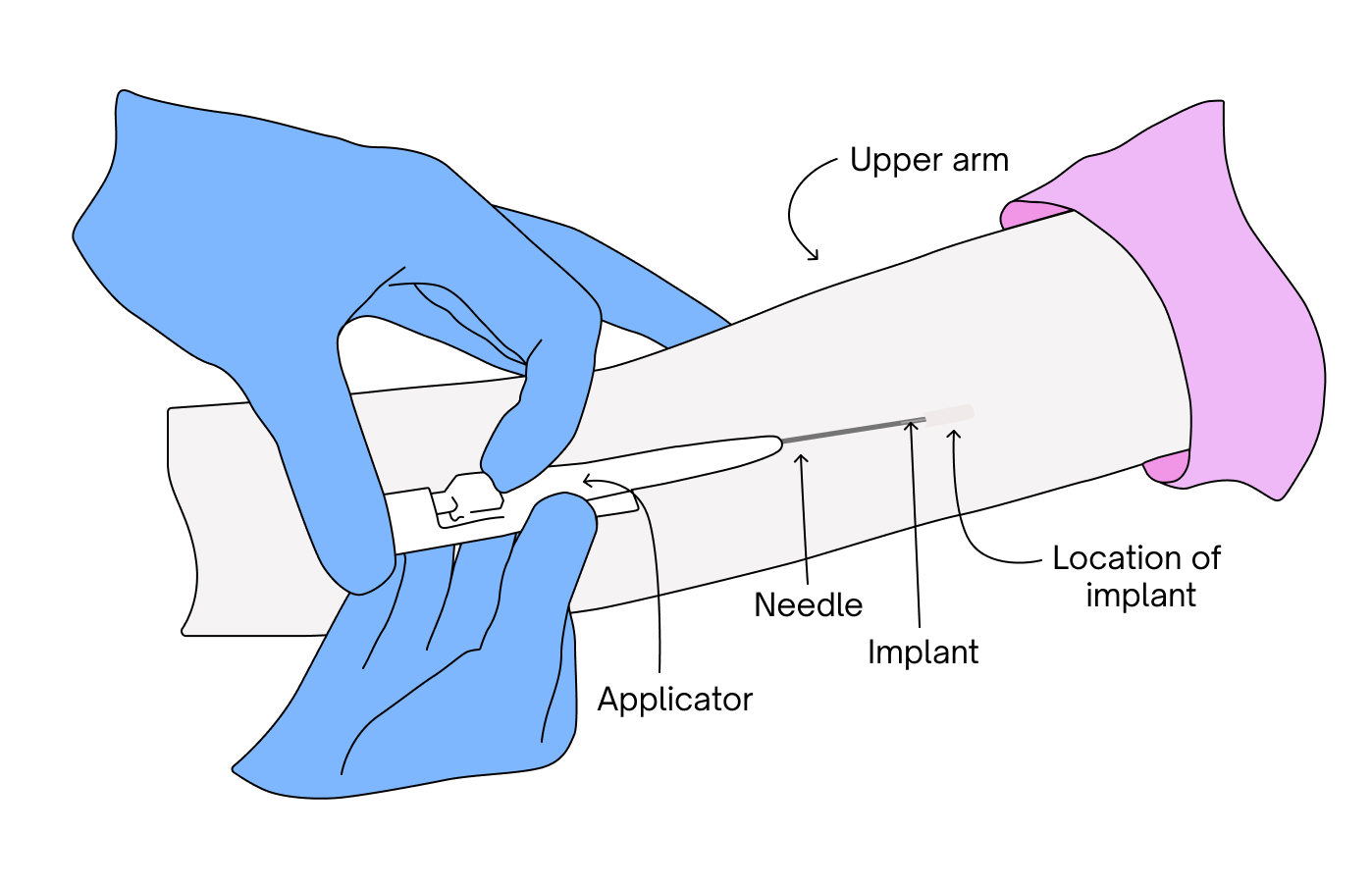What happens when the birth control implant is inserted?
Follows NC° Editorial Policy
At Natural Cycles, our mission is to empower you with the knowledge you need to take charge of your health. At Cycle Matters, we create fact-checked, expert-written content that tackles these topics in a compassionate and accessible way. Read more...
Key takeaways:
- The birth control implant is inserted under the skin of the upper arm in a quick and simple procedure
- The procedure, performed by a trained healthcare practitioner, is straightforward and usually painless after anesthetic is applied. However, there may be some subsequent bruising, scarring, or tenderness after this has worn off
- The implant is safe and rarely causes complications, but there are some potential side effects, most commonly changes in the menstrual bleeding pattern
Keep in mind that different countries and regions use different brands of implants and these may work slightly differently. When considering a new form of contraception, it’s always a good idea to talk to your doctor about the methods available.
How is the birth control implant inserted?
The process of getting an implant is pretty quick and easy. It’s a small procedure, and shouldn’t take very long (usually only a few minutes for the insertion, although the appointment will take longer than that ) [1].
Firstly, your nurse or doctor will most likely ask you a few questions to make sure that the implant is the right birth control method for you. They may ask you questions about your medical history, your menstrual cycle, your blood pressure, whether you smoke or drink alcohol, and they’ll measure your height and weight [2].
Then, you’ll be asked to lie down on a bed or sofa, so your arm is supported comfortably. Your healthcare provider will ask you to put your arm into position, either straight out to the side or bent at the elbow, with your hand near your head. Both of these positions allow your nurse or doctor to insert the implant under the skin of the inner side of your upper arm.
You’ll then be given an injection or spray of local anesthetic to numb the area before the practitioner uses a special device to insert the implant into your arm. The device makes a tiny cut in your arm about 2mm long [2] and inserts the implant. Once the Nexplanon is in place, the device is removed.

Once the implant is inserted, you won’t be able to see it under your skin – but you should be able to feel it. Your healthcare provider will feel the implant under your skin to make sure it’s inserted properly, and they’ll ask you to do the same.
They’ll then cover the insertion site with a small gauze pad and a bandage, which helps to minimize bruising. They’ll usually advise that you keep the bandage on for 24-48 hours.
What does getting an implant inserted feel like?
You may feel a sharp sting when getting your anesthetic shot, but once your arm is numb, you won’t feel the implant being inserted.
When the anesthetic wears off, you may feel some tenderness or swelling where the implant has been inserted, and it may be bruised for a week or two afterwards – but the bandage should help to reduce the risk of birth control implant bruises.
What are the side effects?
The contraceptive implant is extremely safe, and it’s very rare to have any serious side effects[3]. But there are a few potential side effects that it’s important to be aware of:
Infection or implant moving out of place
- Once the Implanon or Nexplanon implant has been inserted, you won’t be able to see it under the skin, but you should be able to feel it – but very rarely, the implant may move out of place. If you can’t feel the implant under your skin, get in touch with your doctor.
- The implant shouldn’t cause you any pain or discomfort, but there’s a possibility that it may become infected. If you have any pain or notice any changes to your skin, contact your healthcare provider for advice.
Scarring or bruising
- Bruising is a fairly common side effect of the contraceptive implant and the area around the implant may be bruised and tender for a week or so after insertion. [1]. However, once it’s healed, there shouldn’t be any pain around your implant, and bumping your arm won’t cause any damage.
- There may be a small scar where the implant was inserted, around 2mm (0.07 inches) long. This is usually barely noticeable and is likely to fade over time.
Changes to your period
- The most common side effect after getting the implant is changes in your menstrual bleeding pattern, which tends to become more irregular. [4]
- Most people experience less frequent and lighter periods – with 20% of people having no periods at all. Some might instead experience shorter cycles, heavier and longer bleeding, or spotting in between periods.[5]
- After the insertion, it can take about 3 months for the bleeding pattern to settle down [2] After that the bleeding pattern will likely remain the same for the rest of the time the implant is used.
- It’s usually nothing to worry about if you don’t get a period while you have the implant – and for many people, including those with PMS or with painful periods, this may be a welcome side effect.
Other side effects
Some other reported side effects of using the birth control implant include [5]:
- Headaches
- Nausea
- Mood changes
- Acne
- Breast tenderness
These side effects are usually temporary, and will settle down for most people after the first few months. However if you experience severe headaches, or these symptoms don’t resolve themselves after 3-6 months, then you should speak to your healthcare provider [5].
It’s also a good idea to keep a record of your symptoms and side effects. This will help you to spot any patterns and will make it easier for you and your doctor to determine whether the implant is causing these side effects or if they may be caused by other factors.
When is it safe to have sex after getting an implant fitted?
You can have sex straight away after getting Nexplanon or Implanon fitted – but you may need to use an additional method of contraception to ensure you’re protected against pregnancy for the first week [6]:
- If your implant is inserted in the first five days after your period begins, you’ll be protected right away and don’t need to use any additional birth control.
- If it’s inserted more than five days after your period started, you should use a backup form of birth control like condoms for seven days.
Find the right birth control method for you
There are lots of different factors to think about when choosing contraception, from effectiveness to family planning. But the most important thing is being armed with the facts about the different birth control methods available, so you can make an informed decision about what’s right for you.
For many people, the implant is a great choice of contraception. But it’s not right for everyone. And even though the implant is long-lasting, remember that it’s okay to change your mind at any time. If you’re ready to remove your implant, whether you want to swap it for another type of birth control or are ready to plan a pregnancy, you can find out more about getting the implant removed here).
Did you enjoy reading this article?
